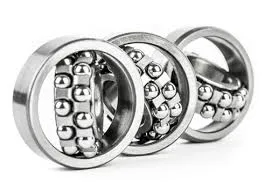
10 月 . 12, 2024 11:17 Back to list
Understanding Different Types of Thrust Bearings and Their Applications in Engineering
Understanding Types of Thrust Bearings
Thrust bearings play a crucial role in machinery and engineering applications by supporting axial loads and allowing rotational movement. These specialized bearings are designed to handle forces that are parallel to the shaft, making them essential in many industrial applications. Below, we will explore the main types of thrust bearings, their characteristics, advantages, and applications.
1. Flat Thrust Bearings
Flat thrust bearings, often made of metal or polymer, consist of two flat surfaces that slide against each other. They are simple in design and can accommodate light axial loads. This type typically requires lubrication to reduce friction and wear between the sliding surfaces. Flat thrust bearings are commonly used in applications where space is limited and precision is not critical, such as in electric motors and small machinery.
2. Thrust Ball Bearings
Thrust ball bearings consist of a set of balls situated between two flat washers. They can accommodate axial loads in one direction only, making them ideal for applications where axial positioning is important. Thrust ball bearings provide low friction and are suitable for high-speed applications. They are commonly used in automotive applications, such as in gearboxes and transmissions, and in various machine tools.
Thrust roller bearings feature cylindrical rollers instead of balls, allowing them to support higher loads compared to thrust ball bearings. They can handle both axial and radial loads, though they excel at axial load distribution. This type of bearing is typically used in heavy machinery, such as construction equipment, turbines, and marine applications. Their robust design makes them ideal for applications subjected to extreme loads and harsh environments.
types of thrust bearings

4. Tapered Roller Thrust Bearings
Tapered roller thrust bearings comprise tapered rollers arranged between two raceways. They are designed to accommodate axial loads and can also handle some radial loads. The tapered shape allows for a larger contact area, improving load distribution and increasing the bearing's overall capacity. These bearings are extensively used in applications such as automobile wheel hubs, gearboxes, and heavy machinery due to their robust design and reliability.
5. Magnetic Thrust Bearings
The advent of magnetic thrust bearings has revolutionized modern engineering. These bearings utilize magnetic forces to support the shaft and eliminate the need for physical contact, resulting in virtually no friction. As a result, magnetic thrust bearings significantly reduce wear and extend service life. They are particularly useful in high-speed applications, such as turbomachinery and medical devices, where traditional bearings might fail due to excessive heat generation.
Conclusion
The choice of thrust bearing significantly influences the performance, reliability, and lifespan of mechanical systems. Each type of thrust bearing offers distinct advantages and is suited for specific applications based on load capacities, speed, and environmental conditions.
Understanding the different types of thrust bearings helps engineers make informed decisions, ensuring optimal design and performance in various fields, including automotive, aerospace, and industrial machinery. As technology continues to advance, the development of new bearing materials and designs promises to enhance the efficiency and functionality of thrust bearings, catering to the evolving demands of modern engineering. By selecting the appropriate type of thrust bearing, manufacturers can improve machinery performance, reduce costs, and ensure greater durability in their products.
Latest news
-
Unlocking Efficiency with Spherical Roller Bearings
NewsOct.29,2024
-
The Ultimate Guide to Thrust Ball Bearings
NewsOct.29,2024
-
The Power of Thrust Roller Bearings: Engineered for Excellence
NewsOct.29,2024
-
The Power of Deep Groove Ball Bearings for Your Application Needs!
NewsOct.29,2024
-
The Power and Performance of Cylindrical Roller Bearings
NewsOct.29,2024
-
High-Quality Ball Bearing Manufacturing Machines
NewsOct.29,2024
